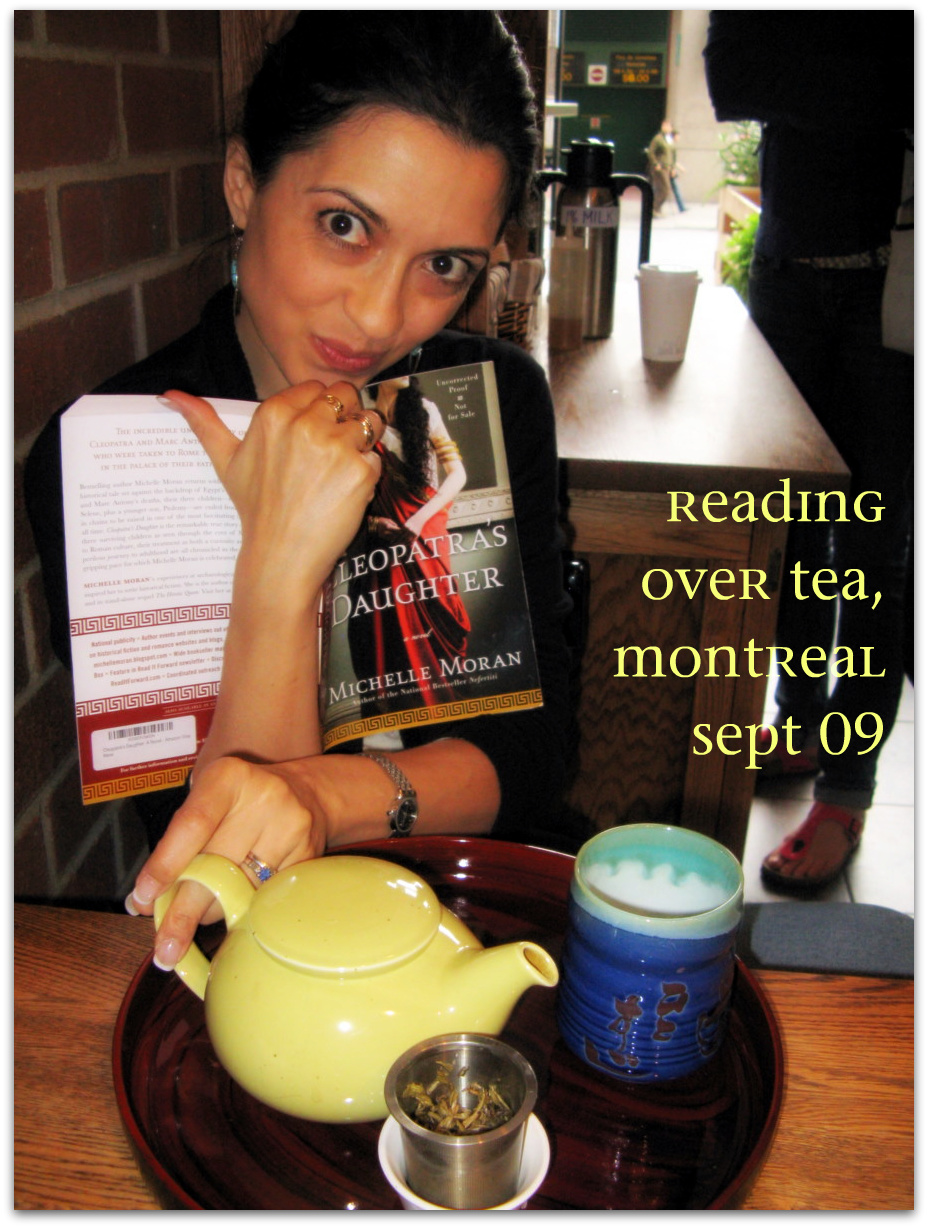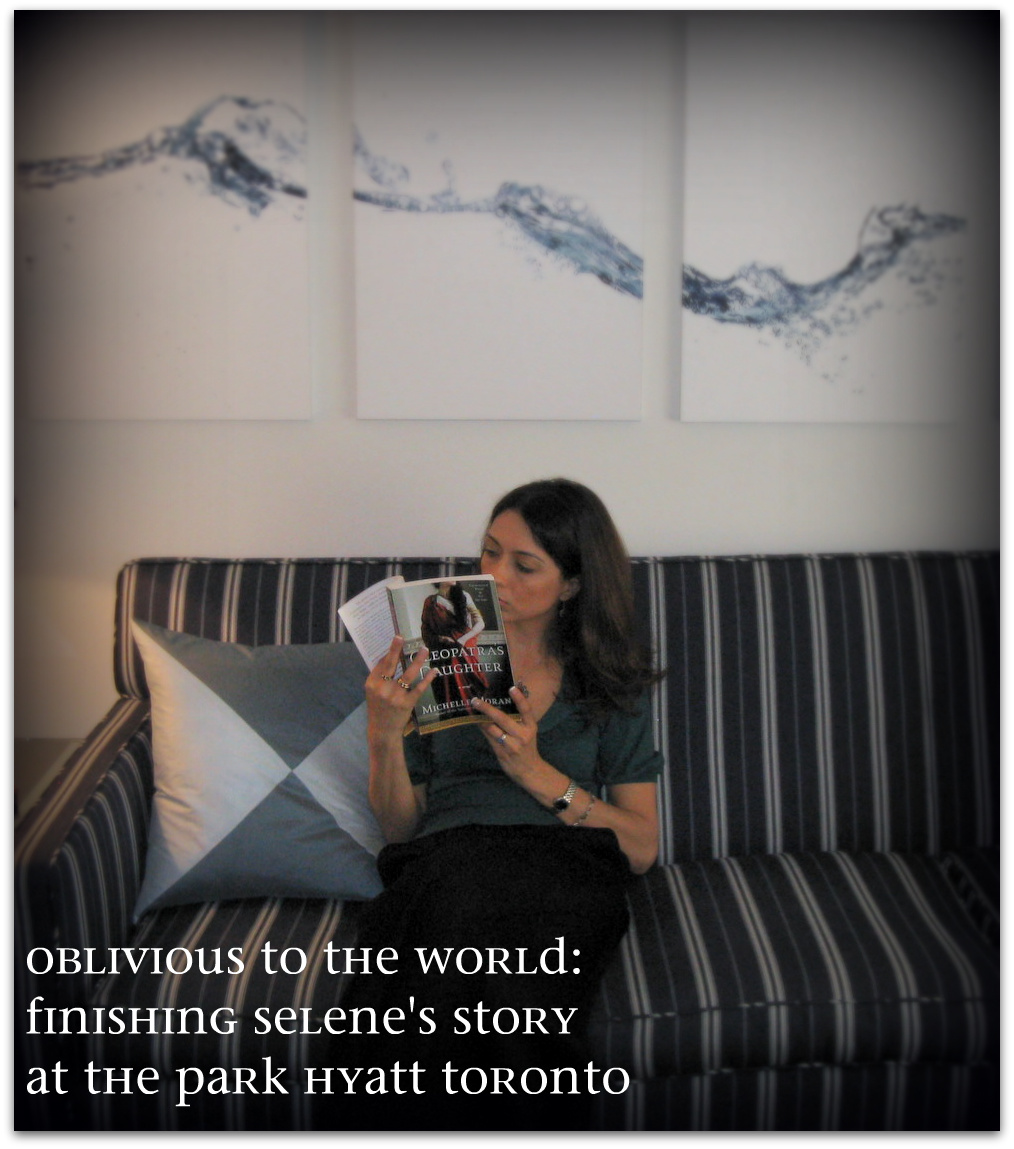 What did I do on a 4-day vacation in Montreal in September? We came to Canada a few days before Toronto International Film Festival and Montreal was the obvious traveler’s guide choice in which to spend a few late summer days. We walked countless miles every day, and while I found the people warm and the climate superb and the food choices plenty, I was slightly bored with the city. So we hit the coffee shops and fancy Chinese tea spots and the Hyatt lounge far too frequently. In these hours over tea or espresso, I voraciously read through the 427-page fantastic tale of Cleopatra’s Daughter by Michelle Moran.
What did I do on a 4-day vacation in Montreal in September? We came to Canada a few days before Toronto International Film Festival and Montreal was the obvious traveler’s guide choice in which to spend a few late summer days. We walked countless miles every day, and while I found the people warm and the climate superb and the food choices plenty, I was slightly bored with the city. So we hit the coffee shops and fancy Chinese tea spots and the Hyatt lounge far too frequently. In these hours over tea or espresso, I voraciously read through the 427-page fantastic tale of Cleopatra’s Daughter by Michelle Moran.
Note: In the book, all reference to Kleopatra are spelled with a K, whereas the title remains true to original spelling with C, as do most history books and Wikipedia. I will use the prominent spelling in this review.
I had a notion that the Pantheon in Rome held great secrets behind those massive columns and exquisite marbles, but I never thought that the hand and mind of an Egyptian Queen’s daughter, barely of age, was at work in creating the architectural designs. The story of Selene Cleopatra, one of my best choices yet from Amazon Vine program. This novel is based on the true historical tale of the collapse of the Egyptian kingdom and rise of the Roman Empire, told through the eyes of Selene, Cleopatra VII and Mark Anthony’s daughter, taking place between 30BC and 25BC.
When Octavian (later Augustus) defeats Mark Anthony‘s forces in Egypt in August of 30 BC, the children of Anthony and Cleopatra (VII), the 3 Ptolemys, are taken back to Rome on a 2-month journey via a ship vessel. Selene and his twin brother Alexander survive the trip but the climate and fevers prove too much for 6-year old Ptolemy who does not survive. For the next 5 years, Selene recounts her tales of living in Rome with her brother Alexander with Octavia (Octavian’s sister and former wife to Mark Anthony), and these tales vary from the most personal struggles and adjustments to the vast differences she observes between Alexandria, “the greatest city on earth”, and Rome, which she finds less than impressive in beauty and more than horrifying in ways of its civilization.
Michelle Moran’s writing style flows with ease and eloquence. It is a story told mainly in dialogue form. The pungent historical facts and incisive accounts of Roman Empire, weaved into the story along with the Latin expressions and descriptive traditions of the ancient Rome and Egypt worlds, all indicate the mastery of subject matter on Michelle’s part, and I commend her for writing a thoroughly researched novel. I particularly enjoyed a rarely seen commentary at the end where she distinguishes between fact and fiction, and putting everything in better context for the reader.

Over 2000 years ago, the Roman Empire comfortably and forcefully ruled over a better part of the world, never ceasing to conquer additional territories and claiming to be the rightful owner of all land, treasure, and people. Their way of life always raises a keen interest for me, especially in light of (no pun intended) Dark Ages that befall Europe for decades after the fall of the Empire. From the established laws and courts in the senate to the forum shops and markets, the baths, the business and trade, and the obvious: the mastery at architecture and erecting jaw-dropping colossal temples, monuments and buildings. With enough slaves and money, they achieved many seemingly impossible tasks, but there was the undeniable brutality and harshness of the empire that can be overlooked or forgotten when gazing into the beautiful structures left behind.
In reading Selene’s observations of Rome and the Roman Empire’s way of life, she finds it hardly impressive compared to Egypt. This is not because she was brought over from a majestic castle and moved to a lesser palace at Palatine. It is as a result of the everyday ordinary lives of people she witnesses, from the conventions of mannerism, ideals, education system, parenting, courts, laws, justice system, treatment of men and women, and even far more crucial issues such as slavery, unwanted pregnancies and babies, and marriage arrangements for women, even to siblings and cousins and men old enough to grandfather them. In all these matters and more, the Egyptian Queen’s daughter encounters shock after shock when faced with the Roman Empire’s ways of life. She finds them uncivilized, lacking logic and decency in their way of life, and this only makes missing Alexandria more unbearable. These accounts fascinated me the most in her tale, and it filled me up with a huge interest in further reading of the Egyptian history.
Reading is the best pastime for an active mind! If you like to see the other book reviews, check the index of In Print.
It was not hard to see that Selene and Alexander’s education at the age of 10 was far above and beyond even their Roman peers, Julia (daughter of Octavian – Augustus), Marcellus (son of Octavia) and Tiberius (son of Livia, current wife of Augustus), to name a few. If you think that the families are a bit too intertwined, in terms of blood relative proximity, you should read the book to really sense the broken boundaries of blood lines. But I digress. The education that Selene had achieved by the age of 10 was awe inspiring: speaking fluently in 5 languages as one and a masterful drawing skill of buildings, cities, palaces, and gardens to name a few, she was indeed a Queen’s daughter. If and only if education and the training of the mind in classic disciplines were still an observed value and tradition in society, what a grander life we would all live.
Even though Selene and Alexander were twins, their fate could not have been more unexpected and diverse. Ironic in retrospect how much Selene worried about their execution at the hands of Augustus while Alexander spent his days more carefree, playing games, betting on horse races and taking in a lover before their eminent nuptials. I suspect that Michelle Moran would have found a way to balance the huge stroke of misery and bad luck befalling Selene, but alas, she did not have to make up a happy ending. History afforded her one. And she has repaid that happiness in return with the massive contributions she made to society and humanity when she became Queen. Selene Cleopatra mourned her deep losses and yet managed to find happiness in her circumstances and even the will to build, create, provide, educate, bear children, and be in love. And that is the spirit of a magnificent human being, an example for all humanity to learn from to this day, and for ages to follow.

 I am Farnoosh, the founder of Prolific Living. So glad you are here. My mission is to empower you to unblock your creative genius to live your dream life.
I am Farnoosh, the founder of Prolific Living. So glad you are here. My mission is to empower you to unblock your creative genius to live your dream life.